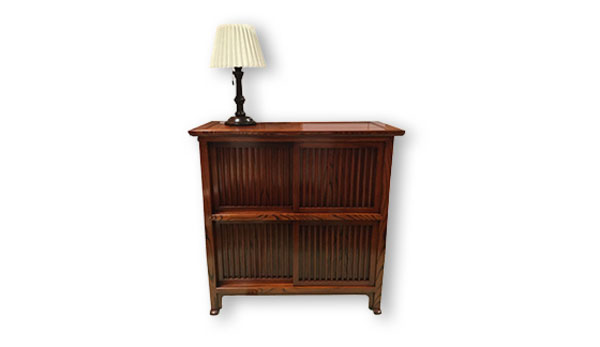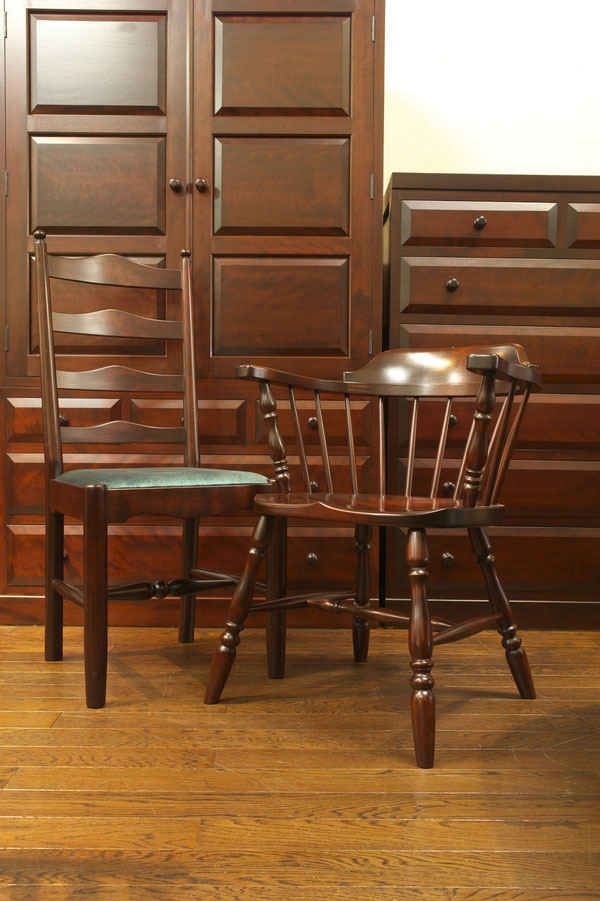
- Wood, bamboo crafts
- Nagano
Matsumoto furniture Matsumoto kagu
Familiar designs in harmony with our living space
Warm furniture that ages gracefully
Description
What is Matsumoto furniture ?
Matsumoto kagu is a type of Japanese traditional furniture made in the city of Matsumoto in Nagano prefecture and has been produced for over three hundred years, since the Edo period (1603-1868). The Second World War led production of this craft to be temporarily suspended, but Sanshiro IKEDA, a folk crafts proponent, applied Western furniture techniques to Japanese traditional furniture, which then evolved to become the blending of Japanese and Western styles that we know now.
Matsumoto furniture is distinctive not just because of the natural beauty of the wood, but also for the traditional wood joinery technique, kumite-tsugite used in the assembly of each piece. Natural wood from Japanese cherry birch, chestnut, oak, and zelkova is skillfully lumbered, assembled and lacquered. A notable piece of Matsumoto furniture is based on a Windsor chair made in the frontier days of the United States. It is a quality and durable product. Matsumoto furniture is appreciated for mixing tradition with modernity and becoming comfortably warm with continuous use.
History
This craft was first produced in Matsumoto in the middle of the sixteenth century, but it was not until the Edo period that it began to appear in the homes of ordinary people. Then, in the late Taisho period (1912-1926), Matsumoto became known for the production of traditional Japanese furniture. Unfortunately, the run-up to World War II forced the suspension of production for a certain period of time.
In 1948, Sanshiro IKEDA, was inspired by a speech made by Muneyoshi YANAGI, a philosopher known for his promotion of folk art, and began to lead former wood artisans toward the revival of Matsumoto kagu. A wood artisan named Keiichi YASUKAWA and ceramists, Shoji HAMADA and Kanjiro KAWAI, also trained artisans. In addition, in 1953, Bernard LEACH came to Japan from the United Kingdom and taught production methods for the Windsor chair. It was thanks to the efforts of these men that Matsumoto furniture resumed production, and then in 1974, it was the first furniture item to be designated as a national traditional craft by the former Ministry of International Trade and Industry. It is said that this craft now has well over a thousand designs and is enjoyed by furniture lovers.
General Production Process
 Photo:Shinshu・Nagano Prefecture Tourism Association
Photo:Shinshu・Nagano Prefecture Tourism Association
- 1. Wood
The production of Matsumoto furniture begins with the inspection of wood materials. Japanese cherry birch is the prominent wood but other types including oak, chestnut and zelkova are used according to their natural qualities and the beauty of their wood grain.
- 2. Natural drying
The selected wood materials are cut at a sawmill and left in outdoor piles to dry naturally for anything from six months to two years, or even five to ten years depending on the size of the timber. While the amount of time it will take depends on their classification and thickness, the wood is left to dry until the water content is less than 30%.
- 3. Machine drying
Once the water content has dropped below 30%, the wood is dried in a dryer for about seventy to eighty hours, until the water content is around 8-9%. Then the wood is left to season for about a month so that it is durable enough to make good furniture.
- 4. Pattern design
The patterns of Matsumoto furniture are individually handwritten and drawn by craftsmen. First, the designs are in small-scale, then full size, detailed drawings are made from sketches, and paper templates are created from the drawings. The craftsman makes each pattern while imagining if each part of the item is in harmony not only with itself, but also with the type of place the furniture will be used.
- 5. Cutting to size
After finishing the design, the wood planks are cut to the proper size. At first, craftsmen select wood materials which match the purpose of the furniture and line or mark it. Then the materials are cut horizontally and vertically or in a curved shape and thin planks.
- 6. Metal ornaments
The metal ornaments are made of copper and iron, cut according to the paper templates, and hand filed to shape. The specially shaped parts include drawer handles shaped by firing. The heat also colors the lacquer and floss silk. After polishing with wax, the items become quite shiny.
- 7. Cutting wood joints
Matsumoto craftsmen use a variety of wood joints. The skills to make them have been traditionally passed down for generations.
- 8. Assembly
After the wood joinery pieces have been cut and chiseled, they are temporarily assembled, which is also when they are checked for any defects as most errors cannot be fixed during the final assembly. After the adjustment of errors, the piece is disassembled and ready for final assembly, gluing, and the smoothing of any rough areas.
- 9. Coating
Once the glue has set, lacquer is applied by artisans. There are two kinds of coating methods: lacquer and wiped lacquer coating, although mainly wiped lacquer coating is used because of its durability. The furniture is hand-coated with at least eight coats of lacquer which adds beauty, durability in long-term use, and brings out the depth of the wood grain.
Any metal ornaments, lathe-turned parts, doors and drawers are fitted. Then there is a thorough check that everything is working smoothly and closing properly. After the final check, the Matsumoto furniture is complete.
Where to Buy & More Information
Matsumoto Folkcraft Museum
-
Address
-
Tel.=81-263-33-1569
-
ClosedMondays (open if Monday is a holiday and closed the next day), December 29 to January 3
-
Business Hours9am to 5pm
-
Website
See more Wood, bamboo crafts
- Hakone wood mosaic
- Iwayado traditional chest
- Kaba cherrybark woodcrafts
- Odate bentwood
- Inami wood carvings
- Matsumoto furniture
- Beppu bamboo crafts
- Edo wood joinery
- Ichii woodcarvings
- Suruga bamboo crafts
- Edo bamboo fishing rods
- Kishu bamboo fishing rods
- Kamo traditional chest
- Kyo wood joinery
- Miyakonojo archery bows
- Osaka carved wooden panel
- Miyajima woodwork
- Nibutani carved wooden tray
- Okuaizu Basketry
- Echizen traditional chest
- Kasukabe traditional paulownia chest
- Katsuyama bamboo crafts
- Osaka karaki wood joinery
- Takayama tea whisks
- Toyooka wicker crafts
- Akita cedar tubs and barrels
- Nagiso woodturning
- Kishu traditional chest
- Nagoya traditional paulownia chest
- Osaka bamboo screens
- Osaka-senshu traditional paulownia chest
- Sendai traditional chest































































































































































































































































































